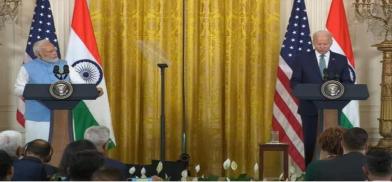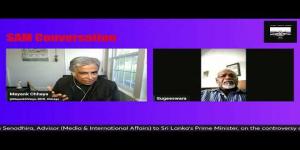Modi's state visit to the US: A visit rich in style and substance
From Modi's standpoint, the visit unfolded precisely as he desired. The exceptional reception he received from the leader of the free world, less than a year before facing the billion-strong Indian electorate, serves as a significant boost for him.

Indian Prime Minister Narendra Modi received a reception in Washington, befitting a state visit by the leader of the world's largest democracy. It was characterized by grandeur, splendor, and all the essential ceremonial elements. During his three-day stay in the US, India and the United States showcased the substantial nature of their relationship, reaffirming the upward trajectory it has been following for more than two decades.
Among the highlights of the visit were a welcome ceremony hosted by President Joe Biden and First Lady Jill Biden on the South Lawn of the White House, an address to the joint session of the US Congress and a state dinner hosted by the Bidens.
The trip, only the third state visit by an Indian leader, also comprised a range of substantive discussions, strategic meetings, and diaspora engagements, indicating the comprehensive nature of the bilateral ties between India and the US.
A visit of great significance
In an era when state visits have become increasingly infrequent, as US presidents have become more preoccupied with domestic affairs and the nation has become more politically divided, PM Modi's trip assumed great significance for a variety of reasons including the following:
PM Modi became only the second foreign leader in this century to address the US Congress twice, following in the footsteps of Israeli Prime Minister Benjamin Netanyahu, who has the distinction of addressing Congress three times. Modi's first address to a joint session of Congress took place in 2016.
The significant involvement of the Indian American community, which has become a hallmark of the Modi era, was another prominent feature of the visit. In the past, prime ministerial visits primarily focused on bilateral engagements in Washington. However, Modi has incorporated a community angle to nearly every foreign visit, leveraging the strength and influence of the Indian diaspora to a remarkable extent.
In 2014, during his first visit to the United States as Prime Minister, he addressed a gathering of over 14,000 Indian Americans at Madison Square Garden, marking the largest gathering of Indian Americans at a political event up to that point. Five years later, in 2019, Modi surpassed that achievement when a staggering 50,000 Indian Americans congregated at the Namaste Modi event at the NRG Stadium in Houston, which was also attended by President Donald Trump.
Continuing the tradition he started, according to various media outlets, the Washington visit saw the attendance of an estimated 4,000 to 7,000 Indian Americans at the welcome ceremony on the South Lawn. In recent times, only Pope Benedict XVI in 2008 drew a larger crowd to the White House. Additionally, Prime Minister Modi addressed two other public events, both attracting more than a thousand Indian Americans.
Showcasing Indian Americans
The state dinner, which I had the privilege of attending, showcased the presence of numerous distinguished Indian Americans from diverse backgrounds, exemplifying the community's richness and achievements. Attendees ranged from CEOs of major American tech companies, including Sundar Pichai of Google and Satya Nadella of Microsoft, and filmmaker M. Night Shyamalan to political figures like Cincinnati Mayor Aftab Pureval and prominent Biden administration officials such as Neera Tanden, Vanita Gupta and Richard Verma. Their collective presence at the dinner served as a joyous celebration of the Indian American community and its contributions to both the United States and India.
The business side of the trip also moved the needle of the US-India relationship quite a bit, with the two sides reaching agreements on cooperation in several key areas, including trade, defense, technology, and climate change, underscoring their shared priorities and mutual interests.
Addressing a meeting of senior officials and technology leaders on June 24, the day after the state dinner, Biden put the bilateral relations in context, saying that the U.S.-India “partnership is about more than the next breakthrough or the next deal — as big as they may be.”
President Biden went on to elaborate that the broader strategic goals encompass addressing climate change, exploring space, combating poverty, finding cures for diseases, preventing pandemics, providing equal opportunities for all citizens, creating a better future for our children, promoting democracy, and upholding our values and global vision.
“[The] partnership between India and the United States will go a long way, in my view, to define what the 21st century looks like,” Biden stated, echoing a phrase from President Barack Obama, who famously said during a state visit by Modi’s predecessor Manmohan Singh that “the relationship between India and the United States will be one of the defining partnerships of the 21st century.”
A well choreographed visit
In the lead-up to the visit, several media outlets and experts from various think tanks had attributed the strengthening ties between Washington and New Delhi to the containment of China, a rising superpower. Interestingly, however, China did not feature prominently in any of the discussions while Modi was in DC.
Discussions on whether India can ever become a formal US ally were prevalent in respected foreign policy publications and op-ed pages of prominent newspapers. However, many of these analysts overlook the changing international paradigm. While India may not be a treaty ally in the same sense as the United Kingdom or Japan, Washington and New Delhi can forge a robust partnership without needing to be one.
From Modi's standpoint, the visit unfolded precisely as he desired. The exceptional reception he received from the leader of the free world, less than a year before facing the billion-strong Indian electorate, serves as a significant boost for him. During various engagements in Washington, he proudly highlighted India's accomplishments under his leadership over the past nine years. In fact, portions of his address to the joint session of Congress resembled a campaign stump speech.
As expected, Modi faced questions regarding the erosion of Indian democracy and the treatment of Muslims in India over the past nine years. During a joint press appearance at the White House, an Indian American reporter posed the question, and Modi was prepared to address it, as his answer to the question made it clear. He downplayed the impact on Muslims and emphasized the accomplishment which had benefitted them.
In summary, Modi’s visit was well choreographed in all aspects. It was not a show or a play written for the stage but it was definitely a well-scripted performance which received good reviews.
(The author is an entrepreneur, civic and thought leader based in Washington DC. Views are personal)
And social Media. Biden fell for it. This visit might to a degree bring about positivity around BJP. If next elections in india are lost to BJP, Ondia will change its constitution
And be much closer to
A hindutva rashtra














Post a Comment